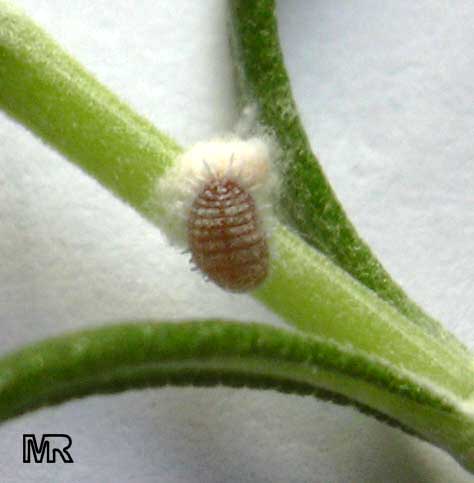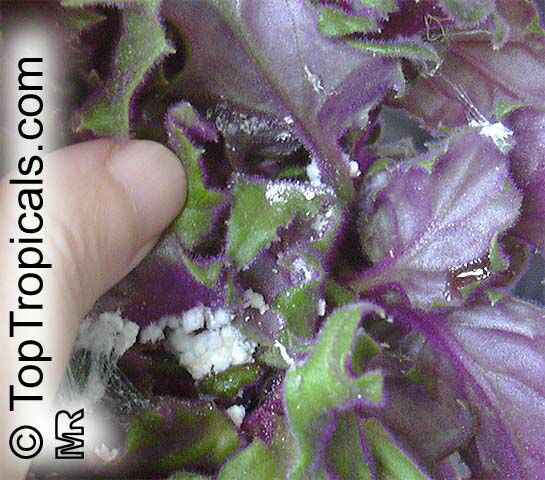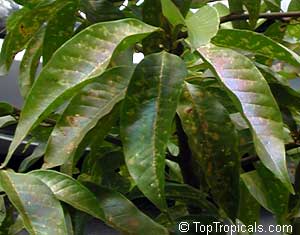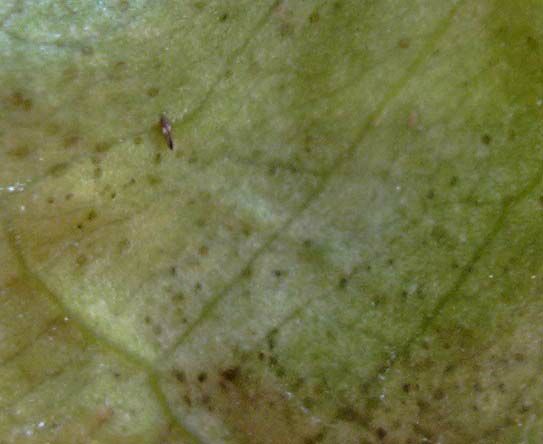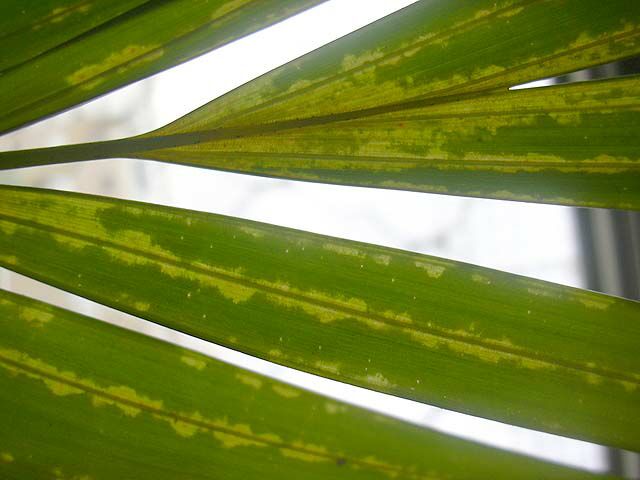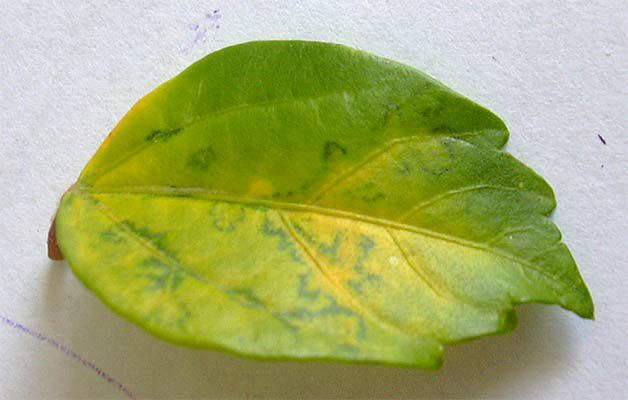Tropical Plant Diseases and Pests Identification
Pests
Photo Name, description and damage symptoms Management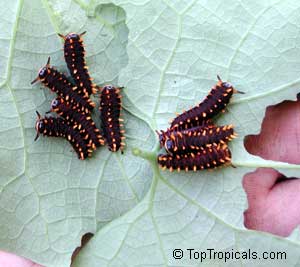
Caterpillar
While you like butterfly plants like passiflora, aristolochia or asclepias - no way you like what their babies-caterpillars do to them...
Most times, mechanical controls are effective. When young trees are heavily infested, the use of insecticides may be warranted. If a biological insecticide is used such as Bt (Bacillus thuringiensis), be sure to spray the entire foliage that is being affected. Caterpillars must eat a good amount of the treated foliage to be sickened. Bt is most effective for managing small, young larvae in the spring. If a contact insecticide is used, treat the larvae that congregated in the early morning. This way, you do not have to spray the entire tree, just the tents. In doing this, be sure that your pesticide is penetrating the tent. Making tears into the tents may be worthwhile before you spray. As the caterpillars mature, it is important that the surrounding foliage is also treated; the caterpillars disperse from the tent as food becomes scarce. As with all our chemical recommendations, be sure to read and follow the label. Be sure to distinguish label directions for fruiting, edible trees and ornamental trees.
Aphids
Aphids are small, soft-bodied insects with long, slender mouth parts that they use to pierce stems, leaves, and other tender plant parts and suck out plant fluids. Almost every plant has one or more aphid species that occasionally feeds on it. Many aphid species are difficult to distinguish; however, identification to species is not necessary to control them in most situations.
Aphids may be green, yellow, brown, red, or black depending on the species and the plants they feed on. A few species appear waxy or woolly due to the secretion of a waxy white or gray substance over their body surface. All are small, pear-shaped insects with long legs and antennae. Most species have a pair of tubelike structures called cornicles projecting backwards out of the hind end of their bodies. The presence of cornicles distinguishes aphids from all other insects.
Generally adult aphids are wingless, but most species also occur in winged forms, especially when populations are high or during spring and fall. The ability to produce winged individuals provides the pest with a way to disperse to other plants when the quality of the food source deteriorates.
Although they may be found singly, aphids often feed in dense groups on leaves or stems. Unlike leafhoppers, plant bugs, and certain other insects that might be confused with them, most aphids do not move rapidly when disturbed.
Life Cycle. Aphids have many generations a year. Most aphids in California's mild climate reproduce asexually throughout most or all of the year with adult females giving birth to live offspring (often as many as 12 per day) without mating. Young aphids are called nymphs. They molt, shedding their skins about four times before becoming adults. There is no pupal stage. Some species mate and produce eggs in fall or winter, which provides them a more hardy stage to survive harsh weather. In some cases, these eggs are laid on an alternative host, usually a perennial plant, for winter survival. When the weather is warm, many species of aphids can develop from newborn nymph to reproducing adult in 7 to 8 days. Because each adult aphid can produce up to 80 offspring in a matter of a week, aphid populations can increase with great speed.
Low to moderate numbers of leaf-feeding aphids are usually not damaging in gardens or on trees. However, large populations cause curling, yellowing, and distortion of leaves and stunting of shoots; they can also produce large quantities of a sticky exudate known as honeydew, which often turns black with the growth of a sooty mold fungus. Some aphid species inject a toxin into plants, which further distorts growth. A few species cause gall formations.
Check your plants regularly for aphids--at least twice weekly when plants are growing rapidly. Many species of aphids cause the greatest damage when temperatures are warm but not hot (65° to 80°F). Catch infestations early. Once aphid numbers are high and they have begun to distort and curl leaves, it is often hard to control them because the curled leaves shelter aphids from insecticides or natural enemies.
Many aphid species prefer the undersides of leaves, so turn them over to check them. On trees, clip off leaves from several areas of the tree to check for aphids. Also check for evidence of natural enemies such as lady beetles, lacewings, syrphid fly larvae, and the mummified skins of parasitized aphids. Look for disease-killed aphids as well: they may appear off-color, bloated, or flattened. Substantial numbers of any of these natural control factors can mean that the aphid population may be reduced rapidly without the need for treatment.
Biological Control. Many predators also feed on aphids. The most well known are lady beetle adults and larvae, lacewing larvae, and syrphid fly larvae. Naturally occurring predators work best, especially in a small backyard situation. Commercially available lady beetles may give some temporary control when properly handled, although most of them will disperse away from your yard within a few days.
Aphids are very susceptible to fungal diseases when it is humid. Whole
colonies of aphids can be killed by these pathogens when conditions
are right.
Aphids are small, soft-bodied insects with long, slender mouth parts that they use to pierce stems, leaves, and other tender plant parts and suck out plant fluids. Almost every plant has one or more aphid species that occasionally feeds on it. Many aphid species are difficult to distinguish; however, identification to species is not necessary to control them in most situations.
Where aphid populations are localized on a few curled leaves or new shoots, the best control may be to prune these areas out and dispose of them. In large trees, some aphids thrive in the dense inner canopy; pruning these areas out can make the habitat less suitable.
High levels of nitrogen fertilizer favor aphid reproduction. Never use more nitrogen than necessary. Use less soluble forms of nitrogen and apply it in small portions throughout the season rather than all at once. Or better yet, use a urea-based, time-release formulation (most organic fertilizers can be classified as time-release products as compared to synthetically manufactured fertilizers).
Another way to reduce aphid populations on sturdy plants is to knock them off with a strong spray of water. Most dislodged aphids will not be able to return to the plant, and their honeydew will be washed off as well. Using water sprays early in the day allows plants to dry off rapidly in the sun and be less susceptible to fungal diseases.
Chemical Control. Insecticidal soap, neem oil, and narrow-range oil (e.g., supreme or superior parafinic-type oil) provide temporary control if applied to thoroughly cover infested foliage. To get thorough coverage, spray these materials with a high volume of water and target the underside of leaves as well as the top. Soaps, neem oil, and narrow range oil only kill aphids present on the day they are sprayed, so applications may need to be repeated.
Many other insecticides are available to control aphids in the home garden and landscape, including foliar-applied formulations of malathion, permethrin and acephate (nonfood crops only). While these materials may kill higher numbers of aphids than soaps and oils, their use should be limited because they also kill the natural enemies that provide long-term control of aphids and other pests. Repeated applications of these materials may also result in the development of resistance to the material by the aphid.
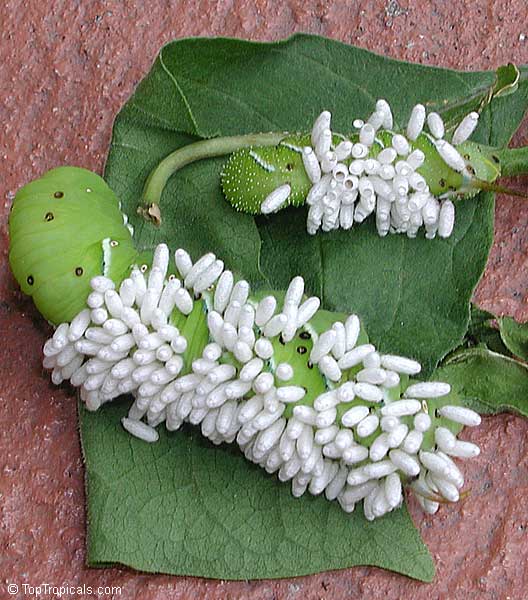
Tomato hornworm with Braconid Cocoons
The larval stage of this insect is a 3 1/2 to 4 inch long pale green caterpillar with 5 pairs of prolegs and a "horn" on the last segment. The two most common hornworms are the tobacco hornworm (7 diagonal white stripes and, most commonly, a red horn) and the tomato hornworm ("V" shaped markings with a horn that is often black). The adult of the tobacco Hornworm is the Sphinx moth. The Five-spotted Hawk Moth is the adult of the tomato hornworm. Both moths are stout-bodied, grayish-colored insects with a wing spread of 4 to 5 inches.
The larva is the damaging stage and feeds on the leaves and stems of the tomato plant leaving behind dark green or black droppings. Though initially quite small with a body about the same size as its horn, these insects pass through 4 or 5 larval stages to reach full size in about a month. The coloration of this larva causes it to blend in with its surroundings and is often difficult to see despite its large size. It eventually will burrow into the soil to pupate. There are two generations a year.
This insect is parasitized by a number of insects. One of the most common is a small braconid wasp. Larva that hatch from wasp eggs laid on the hornworm feed on the inside of the hornworm until the wasp is ready to pupate. The cocoons appear as white projections protruding from the hornworms body. If such projections are seen, leave the infected hornworms in the garden. The wasps will kill the hornworms when they emerge from the cocoons and will seek out other hornworms to parasitize.Handpicking is an effective control in small gardens. Bt (Bacillus thuringiensis) and other insecticides may also be used to control hornworms.

Snails and slugs
- move by gliding along on a muscular "foot." This muscle constantly secretes mucus, which later dries to form the silvery "slime trail" that signals the presence of either pest. Slugs and snails are hermaphrodites, so all have the potential to lay eggs. Adult brown garden snails lay about 80 spherical, pearly white eggs at a time into a hole in the topsoil. They may lay eggs up to six times a year. It takes about 2 years for snails to mature. Slugs reach maturity after about 3 to 6 months, depending on species, and lay clear oval to round eggs in batches of 3 to 40 under leaves, in soil cracks, and in other protected areas.
Snails and slugs are most active at night and on cloudy or foggy days. On sunny days they seek hiding places out of the heat and bright light; often the only clues to their presence are their silvery trails and plant damage. In mild-winter areas such as southern coastal locations, young snails and slugs can be active throughout the year.
During cold weather, snails and slugs hibernate in the topsoil. During hot, dry periods or when it is cold, snails seal themselves off with a parchmentlike membrane and often attach themselves to tree trunks, fences, or walls.
Snails and slugs feed on a variety of living plants as well as on decaying plant matter. On plants they chew irregular holes with smooth edges in leaves and flowers and can clip succulent plant parts. They can also chew fruit and young plant bark. Because they prefer succulent foliage or flowers, they are primarily pests of seedlings and herbaceous plants, but they are also serious pests of ripening fruits, such as strawberries, artichokes, and tomatoes, that are close to the ground.
A good snail and slug management program relies on a combination of methods. The first step is to eliminate, to the extent possible, all places where snails or slugs can hide during the day. Boards, stones, debris, weedy areas around tree trunks, leafy branches growing close to the ground, and dense ground covers such as ivy are ideal sheltering spots. There will be shelters that are not possible to eliminate—e.g., low ledges on fences, the undersides of wooden decks, and water meter boxes. Make a regular practice of trapping and removing snails and slugs in these areas. Also, locate vegetable gardens or susceptible plants as far away as possible from these areas. Reducing hiding places allows fewer snails and slugs to survive. The survivors congregate in the remaining shelters, where they can more easily be located and removed. Switching from sprinkler irrigation to drip irrigation will reduce humidity and moist surfaces, making the habitat less favorable for these pests. Choose snail-proof plants for areas where snails and slugs are dense. Copper barriers can be useful for protecting especially susceptible plants. Though baits can be part of a management program for snails and slugs, by themselves they don’t provide adequate control in gardens that contain plenty of shelter, food, and moisture.Handpicking can be very effective if done thoroughly on a regular basis. Snails and slugs can be trapped under boards or flower pots positioned throughout the garden and landscape. Several types of barriers will keep snails and slugs out of planting beds. The easiest to maintain are those made with copper flashing and screen. Copper barriers are effective because it is thought that the copper reacts with the slime that the snail or slug secretes, causing a flow of electricity. Vertical copper screens can be erected around planting beds. The screen should be 6 inches tall and buried several inches below the soil to prevent slugs from crawling through the soil beneath the barrier. Snails and slugs have many natural enemies, including ground beetles, pathogens, snakes, toads, turtles, and birds, but most are rarely effective enough to provide satisfactory control in the garden.
Snail and slug baits can be effective when used properly in conjunction with a cultural program incorporating the other methods discussed above. However, baits alone will not effectively control snails or slugs. Several types of snail and slug bait products are available. Baits containing the active ingredient metaldehyde are most common. Metaldehyde baits are particularly poisonous to dogs and cats, and the pelleted form is especially attractive to dogs. Metaldehyde snail baits should not be used where children and pets cannot be kept away from them. Some metaldehyde products are formulated with carbaryl, partly to increase the spectrum of pests controlled to include soil and debris-dwelling insects, spiders, and sowbugs. However, carbaryl is toxic to soil-inhabiting beneficials like ground beetles and earthworms and should be avoided if snail and slug management is all that is required. Metaldehyde baits containing 4% metaldehyde are significantly more effective than those products containing only 2% metaldehyde; however, they are also more toxic to dogs and wildlife. Most currently available 4% products are formulated for use in enclosed bait stations to minimize their hazard.
Avoid getting metaldehyde bait on plants, especially vegetables. Baits containing only metaldehyde are most reliable when temperatures are warm or following a rain when snails and slugs are active. Metaldehyde does not kill snails and slugs directly unless they eat a substantial amount; rather, it stimulates their mucous-producing cells to overproduce mucous in an attempt to detoxify the bait. The cells eventually fail and the snail dies. When it is sunny or hot, they die from desiccation. If baiting is followed by cool and wet weather, they may recover if they ingest a sublethal dose. Do not water heavily for at least 3 or 4 days after bait placement; watering will reduce effectiveness and snails may recover from metaldehyde poisoning if high moisture conditions occur. Most metaldehyde baits break down rapidly when exposed to sunlight; however, some paste or bullet formulations (such as Deadline) hold up somewhat longer under conditions of sunlight and moisture.
A recently registered snail and slug bait, iron phosphate (available
under many trade names including Sluggo and Escar-Go), has the advantage
of being safe for use around domestic animals, children, birds, fish,
and other wildlife and is a good choice for a garden IPM program. Ingestion
of the iron phosphate bait, even in small amounts, will cause snails
and slugs to cease feeding, although it may take several days for the
snails to die. Iron phosphate bait can be scattered on lawns or on the
soil around any vegetables, ornamentals, or fruit trees to be protected.
Iron phosphate baits may be more effective against snails than slugs.
Spider Mite
Mites are common pests in landscapes and gardens and can be found feeding on many fruit trees, vines, berries, vegetables, and ornamental plants. Although related to insects, mites are not insects but members of the arachnid class along with spiders and ticks. The spider mites, also called webspinning mites, are the most common mite pests and among the most ubiquitous of all pests in the garden and farm.
To the naked eye, spider mites look like tiny moving dots; however, you can see them easily with a 10X hand lens. Adult females, the largest forms, are less than 1/20 inch long. Spider mites live in colonies , mostly on the under-surfaces of leaves; a single colony may contain hundreds of individuals. The names "spider mite" and "webspinning mite" come from the silk webbing most species produce on infested leaves. The presence of webbing is an easy way to distinguish them from all other types of mites.
Adults have eight legs and an oval body, with two red eyespots near the head end of the body. Females usually have a large, dark blotch on each side of the body and numerous bristles covering the legs and body. Immatures resemble adults, except the newly hatched larvae have only six legs. Eggs are spherical and translucent, like tiny droplets, becoming cream colored before hatching.
Mites cause damage by sucking cell contents from leaves. A small number of mites is not usually reason for concern, but very high populations—levels high enough to show visible damage to leaves—can be damaging to plants, especially herbaceous ones. At first, the damage shows up as a stippling of light dots on the leaves; sometimes the leaves take on a bronze color. As feeding continues, the leaves turn yellow and drop off. Often leaves, twigs, and fruit are covered with large amounts of webbing. Damage is usually worse when compounded by water stress.
Spider mites have many natural enemies that often limit populations. Adequate irrigation is important because water-stressed plants are most likely to be damaged. Broad-spectrum insecticide treatments for other pests frequently cause mite outbreaks, so avoid these when possible. Sprays of water, insecticidal oils, or soaps can be used for management. Always monitor before treatment.
Spider mites frequently become a problem after the application of insecticides. Such outbreaks are commonly a result of the insecticide killing off the natural enemies of the mites, but also occur when certain insecticides stimulate mite reproduction. For example, spider mites exposed to carbaryl (Sevin) in the laboratory have been shown to reproduce faster than untreated populations. Carbaryl, some organophosphates, and some pyrethroids apparently also favor spider mites by increasing the level of nitrogen in leaves. Insecticides applied during hot weather usually appear to have the greatest effect on mites, causing dramatic outbreaks within a few days.
If a treatment for mites is necessary, use selective materials, preferably
insecticidal soap or insecticidal oil. Petroleum-based horticultural
oils or neem oils are both acceptable. Do not use soaps or oils on water-stressed
plants or when temperatures exceed 90°F. These materials may be phytotoxic
to some plants, so check labels and/or test them out on a portion of
the foliage several days before applying a full treatment. Oils and
soaps must contact mites to kill them so excellent coverage, especially
on the undersides of leaves, is essential and repeat applications may
be required. Sulfur dust or spray can be used on some vegetables, but
will burn cucurbits. Do not use sulfur dust if temperatures exceed 90°F
and do not apply sulfur within 30 days of an oil spray. Sulfur dusts
are skin irritants and eye and respiratory hazards. Always wear appropriate
protective clothing.
Mealybug
Mealybugs are part of the insect families collectively known as scale insects. They are soft-bodied, without the outer shell associated with insects in the other scale insect families. Instead, mealybugs are usually covered with a white waxy powder
Mealybugs have sucking mouthparts. Feeding weakens and stunts plants, causes leaf distortion, yellowing, and even total leaf loss. In some cases, plants can be killed. Mealybugs also produce large amounts of honeydew (similar to that produced by whiteflies and aphids), which can coat plants and surrounding surfaces with a sticky layer. A black fungus commonly known as "sooty mold" grows on the honeydew. The presence of honeydew and sooty fungus is one way to detect infestations of these insects.
Life Cycle. The citrus mealybug female can produce about 600 eggs, which are produced in cottony structures called ovisacs. Eggs may be produced with or without males. The eggs hatch in less than 10 days into small nymphs called crawlers. The crawlers move about the plants and locate feeding sites. Once the insects settle, there is not much movement. Under favorable conditions, there may be six generations per year. In reality, generations overlap, so all developmental stages will be present.
Many chemical insecticides list mealybugs.
Non-chemical Control:
- Rubbing Alcohol Spray: Mix 1 to 2 cups alcohol per quart of water. Using undiluted alcohol as a spray is very risky for plants. Since alcohol can damage plants always test your spray mix on a few leaves of plants first. If the spray kills the pests and no leaf damage shows within the next 2 or 3 days, go ahead and spray further, using exactly the same ingredients and proportions you tested. If an infestation is well-established, it will be necessary to make a series of applications, at 10 to 14 day intervals, for mealybug control.
- Insecticidal soap spray according to the dilution on the label but substitute alcohol for half of the water required.
- Horticultural Oil and Insecticidal Soap Sprays: Are effective non-chemical controls for mealy bugs and other soft-bodied pests. Oil sprays suffocate the insects and can aid in controlling scale crawlers and eggs, while soap sprays cause the insects cell membranes to rupture effectively causing it to dessicate.
 Fungus
Fungus
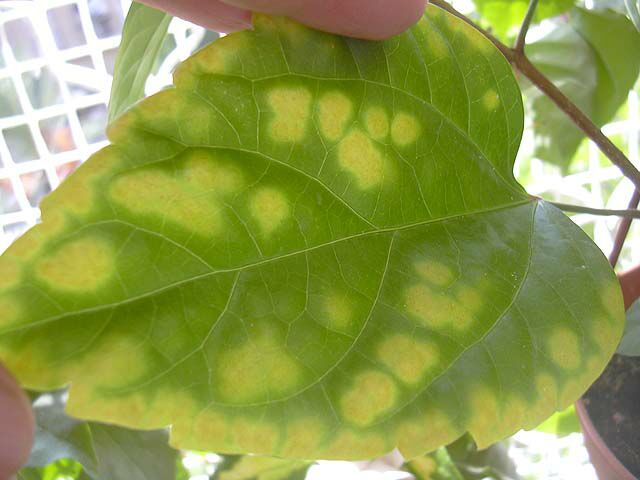

Leaf Curl
Caused by the fungus Taphrina deformans. One of the most common disease problems for backyard gardeners. The distorted, reddened foliage that it causes is easily seen in spring. When severe, the disease can reduce fruit production substantially.
To prevent peach leaf curl, treat the trees every year after leaves have fallen (late November). Copper-based fungicides, tribasic copper sulfate, calcium polysulfides, metallic copper, or synthetic fungicides can be used. However, to be effective, copper-containing compounds must have at least 50% copper; those containing less do not adequately control leaf curl despite advertising claims. If timed properly, a single fall/winter spray will normally prevent losses.In areas of high spring rainfall or when spring rainfall is abundant,
it may be advisable to apply a second copper spray or a lime sulfur
treatment in spring, preferably before buds begin to swell, but definitely
before budbreak (when green color is first visible). Fungicides containing
chlorothalonil also work well at this time.
Scales
Can be serious pests on all types of woody plants and shrubs. Scales are so unusual looking that many people do not at first recognize them as insects. Adult female scales and many immature forms do not move, are hidden under a disklike or waxy covering, and lack a separate head or other recognizable body parts. Scales have long piercing mouthparts with which they suck juices out of plants. They may occur on twigs, leaves, branches, or fruit. Severe infestations can cause overall decline and even death of plants. Most scales have many natural enemies that often effectively control them.
Woody plants heavily infested with armored scales often look water stressed. Leaves may turn yellow and drop, twigs and limbs on trees may die, and bark may crack and produce gum. Many armored scales attack leaves or fruit as well, leaving blemishes and halos on fruit; the fruit damage is often just aesthetic. Some armored scales can kill plants.
Scales are often well controlled by natural enemies, especially when predator and parasite activities are not disrupted by ants or applications of broad-spectrum insecticides such as carbaryl, malathion, or pyrethroids applied to control other pests. If scale populations, especially armored scale species, become abundant, you should take action. In the case of soft scales, controlling ants may be sufficient to bring about gradual control of scales as natural enemies become more abundant. If not, well-timed sprays of oil applied either during the dormant season or when crawlers are active in spring (or, in the case of black scale, in summer) should provide good control.
Dormant-season applications of specially refined oils, often called narrow-range, supreme, or superior type oils, are effective against most scale pests of deciduous trees and landscape plants, especially San Jose scale, walnut scale, and the lecanium scales, but not against oystershell or olive scales because susceptible stages of these pests are not present during winter. Avoid oils called dormant oil or dormant oil emulsions, which are more likely to injure plants. Treatments can be made any time during dormancy or, for sycamore scale and oak pit scales, during the delayed dormant period, which is the time after the buds swell but before they open. Be sure that the plants are not water stressed to avoid injury. A good time to apply oils is right after a period of rain or foggy weather.
An application of oil or soap alone is usually adequate. One study (of sycamore scale) found that organophosphates (e.g., malathion) combined with oil were no more effective than a properly timed, thorough application of oil or soap alone.
Avoid using the organophosphates chlorpyrifos (Dursban) and diazinon in landscapes and gardens because of problems from their runoff in urban surface water and contamination of municipal wastewater.
Nematodes
Microscopic, eel-like roundworms. The most troublesome species in the garden are those that live and feed within plant roots most of their lives and those that live freely in the soil and feed on plant roots.
Root knot nematodes usually cause distinctive swellings, called galls, on the roots of affected plants. Infestations of these nematodes are fairly easy to recognize by digging up a few plants with symptoms, washing or gently tapping the soil from the roots, and examining the roots for galls. The nematodes feed and develop within the galls, which may grow to as large as 1-inch in diameter on some plants but are usually much smaller. The water- and nutrient-conducting abilities of the roots are damaged by the formation of the galls. Galls may crack or split open, especially on the roots of vegetable plants, allowing the entry of soilborne, disease-causing microorganisms.
Management of nematodes is difficult. The most reliable practices are preventive, including sanitation and choice of plant varieties. Existing infestations can be reduced through fallowing, crop rotation, or soil solarization. However, these methods reduce nematodes primarily in the top foot or so of the soil, so are effective only for about a year. They are suitable primarily for annual plants or to help young woody plants establish. Once an area or crop is infested, try to minimize damage by adjusting planting and harvesting dates and irrigation or by the use of soil amendments.
Nematodes are usually introduced into new areas with infested soil or plants. Prevent nematodes from entering your garden by using only nematode-free plants purchased from reliable nurseries. To prevent the spread of nematodes, avoid moving plants and soil from infested parts of the garden. Do not allow irrigation water from around infested plants to run off, as this spreads nematodes. Nematodes may be present in soil attached to tools and equipment used elsewhere, so clean tools thoroughly before using them in your garden.
Whiteflies
Whiteflies are tiny, sap-sucking insects that are frequently abundant in vegetable and ornamental plantings. They excrete sticky honeydew and cause yellowing or death of leaves.
Whiteflies usually occur in groups on the undersides of leaves. They derive their name from the mealy, white wax covering the adult’s wings and body. Adults are tiny insects with yellowish bodies and whitish wings.
Whiteflies suck phloem sap. Large populations can cause leaves to turn yellow, appear dry, or fall off plants. Like aphids, whiteflies excrete honeydew, so leaves may be sticky or covered with black sooty mold. The honeydew attracts ants, which interfere with the activities of natural enemies that may control whiteflies and other pests.
Management of heavy whitefly infestations is very difficult. Whiteflies are not well controlled with any available insecticides. The best strategy is to prevent problems from developing in your garden to the extent possible. In many situations, natural enemies will provide adequate control of whiteflies; outbreaks may occur if natural enemies that provide biological control of whiteflies are disrupted by insecticide applications, dusty conditions, or interference by ants. Avoid or remove plants that repeatedly host high populations of whiteflies. In gardens, whitefly populations in the early stages of population development can be held down by a vigilant program of removing infested leaves, vacuuming adults, or hosing down (syringing) with water sprays. Aluminum foil or reflective mulches can repel whiteflies from vegetable gardens and sticky traps can be used to monitor or, at high levels, reduce whitefly numbers. If you choose to use insecticides, insecticidal soaps or oils such as neem oil may reduce but not eliminate populations.Hand-removal of leaves heavily infested with the nonmobile nymphal and pupal stages may reduce populations to levels that natural enemies can contain. Water sprays (syringing) may also be useful in dislodging adults.
A small, hand-held, battery-operated vacuum cleaner has also been recommended for vacuuming adults off leaves. Vacuum in the early morning or other times when it is cool and whiteflies are sluggish. Kill vacuumed insects by placing the vacuum bag in a plastic bag and freezing it overnight. Contents may be disposed of the next day.
Insecticides have only a limited effect on whiteflies. Most kill only those whiteflies that come in direct contact with them. For particularly troublesome situations, try insecticidal soap or an insecticidal oil such as neem oil or narrow-range oil. Because these products only kill whitefly nymphs that are directly sprayed, plants must be thoroughly covered with the spray solution. Be sure to cover undersides of all infested leaves; usually these are the lowest leaves and the most difficult to reach. Use soaps when plants are not drought-stressed and when temperatures are under 80°F to prevent possible damage to plants. Avoid using other pesticides to control whiteflies; not only do most of them kill natural enemies, whiteflies quickly build up resistance to them, and most are not very effective in garden situations.
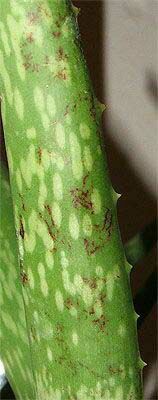
Thrips
Thrips are tiny, slender insects with fringed wings. They feed by puncturing their host plant or animal prey and sucking up exuding contents. Certain thrips species are beneficial predators that feed only on other insects and mites. Beneficial species include black hunter thrips and the sixspotted thrips. Pest species are plant feeders that scar leaf, flower, or fruit surfaces or distort plant parts. Other species of thrips simply feed on fungal spores and pollen.
Feeding by thrips causes tiny scars on leaves and fruit, called stippling, and can stunt growth. Damaged leaves may become papery and distorted. Infested terminals may discolor, become rolled , and drop leaves prematurely. Petals may exhibit "color break," which is pale or dark discoloring of petal tissue that was killed by thrips feeding before buds opened.
Healthy woody plants usually tolerate thrips damage; however, high infestations on certain herbaceous ornamentals and developing fruits or vegetables may justify control. If control is necessary, use an integrated program of control strategies that combines the use of good cultural practices and conservation of natural enemies with the use of least toxic insecticides, such as narrow range oils. Greenhouse thrips biology differs some from that of most other pest thrips.
Although thrips damage to leaves is unsightly, thrips activity does not usually warrant the use of insecticide sprays. For instance, while thrips damage on citrus or avocado fruit may look unpleasant, it does not harm trees or affect the internal fruit quality. Also, by the time damage is noticed on ripening fruit, the thrips that caused the injury are usually gone. While viruses vectored by thrips may cause plant loss, insecticide sprays are not recommended to prevent viruses because thrips are not killed fast enough to prevent the transfer of the virus to new plants. Furthermore, most thrips are difficult to control effectively with insecticides because they are protected within plant parts that surround them as they feed. If insecticides are used, they will only be partially effective and must be combined with appropriate cultural practices and conservation of natural enemies.
Narrow-range oil, neem oil, and other low-toxicity insecticides such as insecticidal soaps or pyrethrins can be somewhat effective for temporary reduction of thrips populations if applied when thrips and damage first appear. These materials have the benefit of allowing at least a portion of the natural enemy populations to survive because they don't leave toxic residues. Sprays must be applied to thoroughly cover susceptible plant tissue, such as new leaf growth and buds. On plants with a history of severe, unacceptable damage, begin treatment early when thrips or their damage is first observed. Repeat applications (usually 5 to 10 days apart, depending on temperature) are usually required because these insecticides only kill newly hatched thrips and recently emerged adults. With most thrips species, eggs are protected within plant tissue and prepupae and pupae are in the soil and will not be killed. No pesticide treatment will restore the appearance of injured tissue; plants will remain damaged until leaves drop or injury is pruned off.
For ornamental nonfood plants, several applications of a systemic insecticide
such as the organophosphate acephate (Orthene) can provide temporary
control of thrips, but this product can be highly toxic to natural enemies.
Another systemic insecticide, imidacloprid (Bayer Advanced Garden, Marathon,
and Merit), is also available.
Any insect which lays its eggs in the spongy layer between the upper and lower surfaces of leaves is known as a leaf miner. Larvae develop between the leaf surfaces and tunnel or 'mine' out the spongy middle layer as they grow, giving leaves a spotty and brownish appearance. The four stages of its development are: egg, larva (leaf miner), pupa, and adult (a small fly).
Although the mines may be considered to be unsightly, this pest can be tolerated as it has little real impact on the health and vigour of a holly. Leaves with mines may turn yellow and drop in early summer but this is the natural shedding of older leaves and not due to the pest.Pinch the leaves of small trees to kill the leaf miner.
Insecticides are unlikely to be effective as the thick glossy surface of holly leaves means that sprays run off the foliage and do not penetrate to where the grubs are feeding. On small specimen plants it is feasible to remove mined leaves but not if this would result in significant defoliation.
When the leaves are fully formed in late April or early May, this is your first opportunity to use insecticides. Managing leaf miners at this time can significantly reduce the chance of a problem later in the season. In June, if populations are severe, time your insecticide application to coincide with the second period of adult flight. Once you’ve noticed that the larvae have left the leaf, start to look for adults emerging two to three weeks later. Apply insecticides when most of the adults have emerged. Using insecticides to manage late season generations is generally not worth it. If late season problems are severe, consider an insecticide application next spring.
More information: Pests in Landscape
Leaf Damage (not a pest problem)
Also see Troubleshooting
Photo Name and description Problem solution Chemical burn
Chemical burn
 Exessive loght
Exessive loght
 Sunburn
Sunburn
 Cold damage
Cold damage
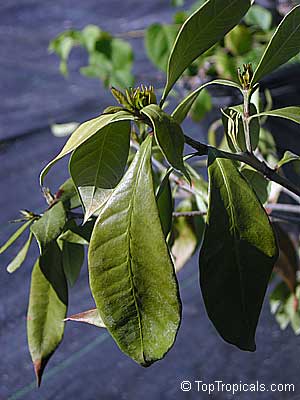 Over-watering
Over-watering
 Chlorosis
Chlorosis
Palm diseases
Please follow links to read more information.

